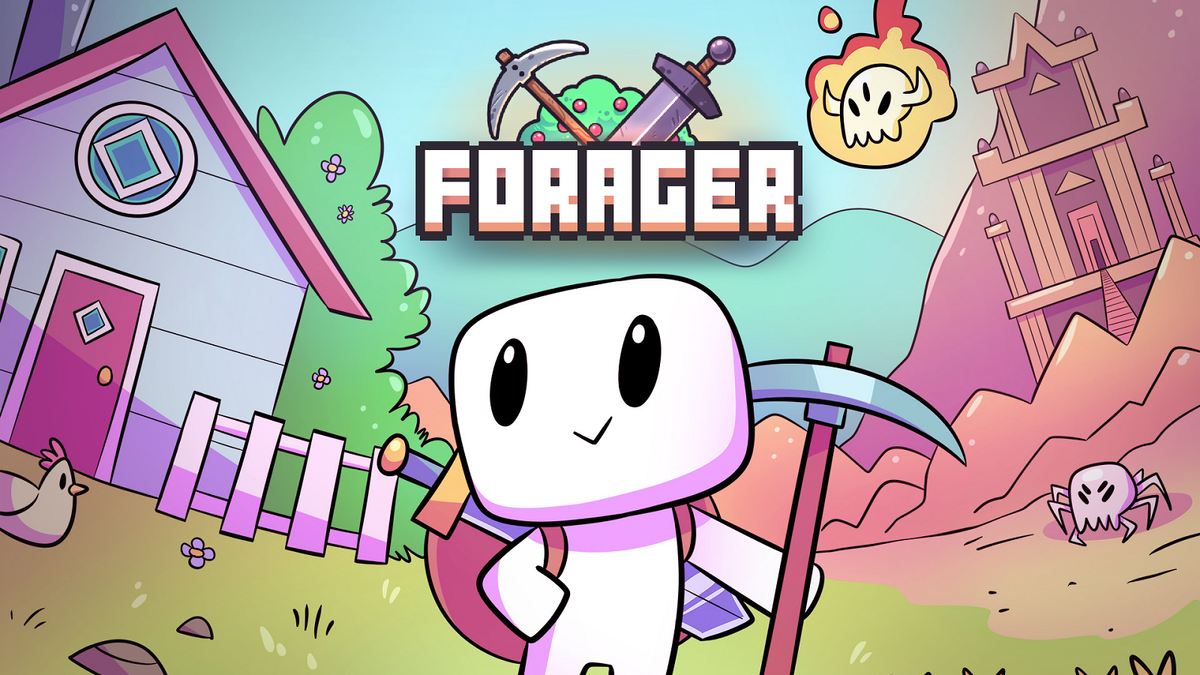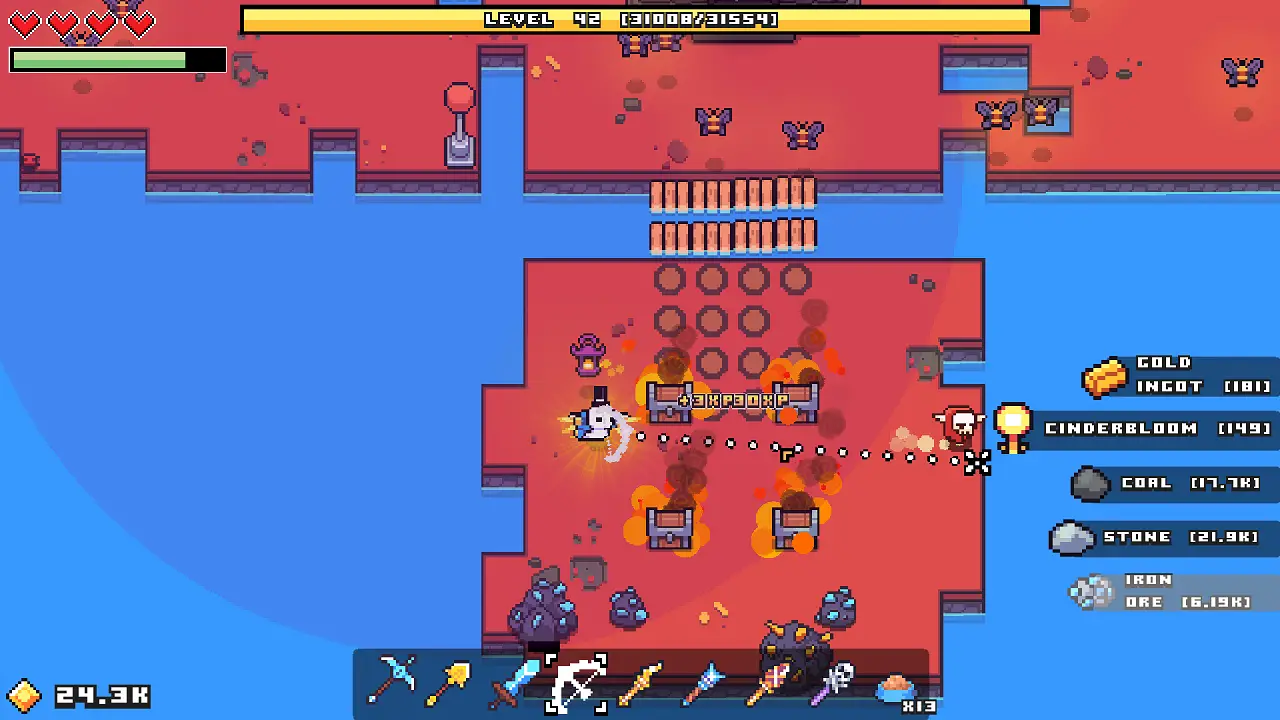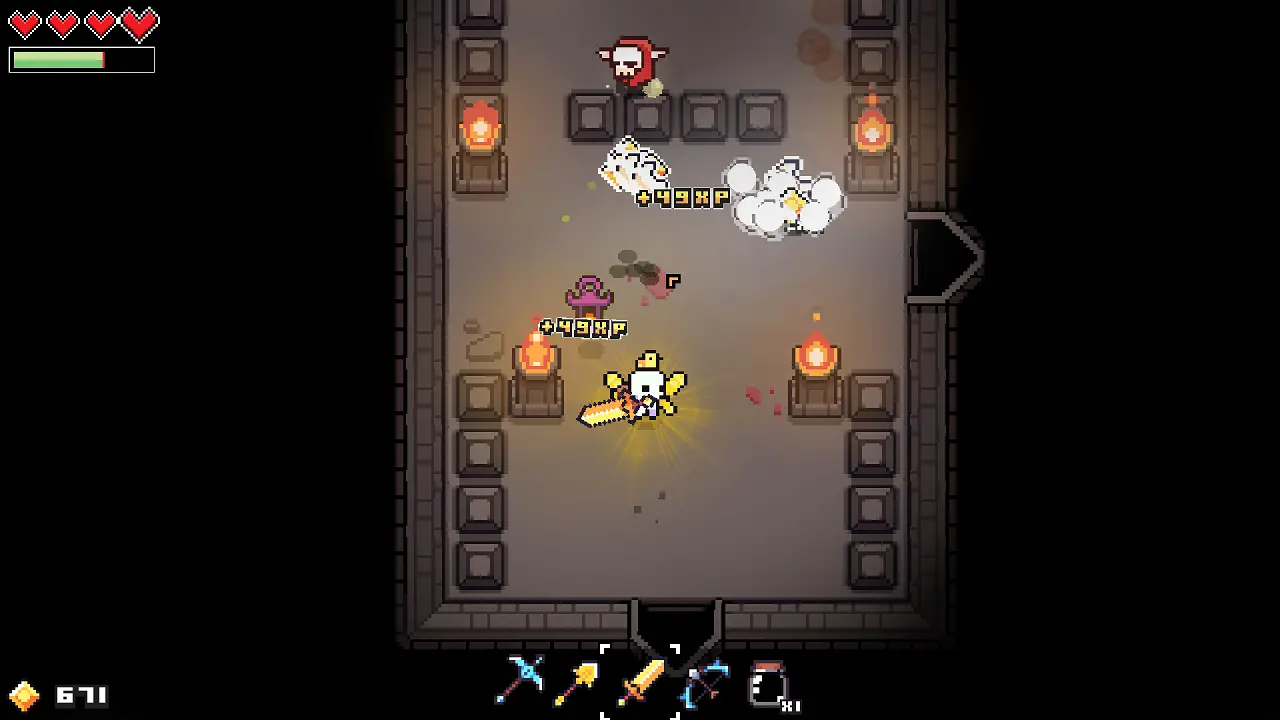
Forager is a tough game to pin down. A sprinkle of casual adventuring, a dash of crafting, and a pinch of idling contribute to the game’s unique flavor. To the avid gamer who is all too familiar with the Minecraft-led survival zeitgeist, Forager’s gameplay trifecta should tread on familiar ground. And it does, but it isn’t without a few tricks of its own. There’s something more in its wiring than the competition, and it breathes new life into this dusty genre framework. Unlike role models Zelda and Minecraft, HopFrog’s debut title doesn’t focus solely on evoking feelings of childhood exploration, nor does it focus on taming and reshaping a vast world to your liking. Forager avoids putting all its eggs into one basket, and in fact, does quite the opposite. The game wants to do it all and then some, letting you, the player, decide which one to tackle first. Forager is what you make of it, and therein lies the beauty.
At the time of writing, Forager sits at 23 hours played, and me at half a dozen changes of heart. In fact, I’m still playing right now, chasing after my next goal despite being an overpowered, landscaping super-weapon surrounded by my personal entourage of mob-slaying, resource-gathering death-machines. And believe me, it’s been quite the roller-coaster. Forager, in a single word, is endearing. From the moment the game launches, players are welcomed to the whimsical world of Forager with eye-catching colors, crunchy sounds, soothing earworms, and countless references. There’s a community art spotlight, roadmaps, quirky credits with custom portraits, and a plethora of extras—all things pointing to a community-centric game. It’s important to keep that in mind going forward.
Forager hands the player a pickaxe and drops them onto a tiny island with nothing to do but start harvesting resources. The first hour of play is ultimately what will make or break the experience for many players. Early harvesting is slow, monotonous work, exacerbated by a steady stream of goals and milestones that continues growing far faster than the player can complete them. But, it’s unfair to say Forager’s early game is slower than that of its contemporaries. However, between the small land masses, limited inventory space, slow harvesting with slow spawning sources, and a curated system of unlocks, it sure gives off that energy. But it’s work that needs to be done if players want to win free reign.
Expanding the play space costs coins, with tougher “tiles” of the map tied to steeper fees in an effort to nudge players down a recommended path. The tiles draw from a bag of presets, meaning every end-game map will contain the same tiles arranged slightly differently. New tiles bring with them additional resources to add to the growing pool, and in gathering them, players gain experience and work towards new structures and gear. Skill points earned through levelling can be allocated into four interconnected branches: Industrial, Farming, Economic, and Magical. By spending skill points, players unlock new structures to build, offering new tools and equipment to increase harvesting efficiency in exchange for resources.
After powering through a slower start, progression is relatively quick for an idle-friendly game. And while rewards often come in the form of improved numbers—extra damage, speedier development, additional inventory slots, or increased dodge rates—Forager keeps gameplay fresh with bonus effects to transform the experience of harvesting and combat, even adding new ways to approach old tasks. Kill and cook all at once by ditching the sword for a fire-infused pickaxe, then replace that with something a little more explosive. The combination of convenience and evolving audiovisual feedback makes for a more engaging reward than your typical number-chasing power crawl.
Puzzle tiles account for a significant chunk of the map but guarantee a worthwhile reward for the player’s efforts. A number are twists on the traditional gear check, others are combination puzzles that, for better or worse, take time to wrap one’s head around. It’s here that Forager reminds the player that nothing is forced onto them. Like with gear checks, it’s viable to let the puzzle be and approach it from a different angle later down the line. NPC tiles dotted around the map fill it with cheery, quest-giving spirits, and although fetch quests are a commonplace in Forager, they encourage players to look deeper into the game’s harvesting system.
Likely the most interesting variation of tiles, and Forager’s nth nod to Zelda, is the existence of dungeons. While these tiles struck me initially as jarring, given what I had perceived this game to be, later they turned into one of Forager’s most charming qualities. The dungeons themselves aren’t particular challenging, even by casual game standards, but they’re microcosms of Forager itself. Explore, hit an obstacle, overcome it, unlock a few upgrades, find a few treasures, and clear the dungeon. And, of course, each dungeon has its own secrets for players to uncover. It’s a shame that dungeons are among some of the most unpolished content Forager has to offer, showcasing the game’s undercooked enemy behavior and combat as well as being home to a fair share of the game’s issues and oversights. Another issue, albeit unrelated, would be the player’s hotbar extending beyond the screen if too many usable items are currently possessed. Yet, dungeons exemplify what it is that Forager does best. The game is a smorgasbord of content, content of varying degrees of quality, but still worth discovering and still worth doing. It toys with your perception of the limits of the game world, continually breaking boundary after boundary until the game is unrecognizable. The way I earned levels come end-game was vastly different to how I had been going about it at the start, and the same goes for how I harvested or dealt with mobs. It’s shocking to see how a progression system that appeared so rigid at hour one became so flexible.
One thing that never came into its own was combat. By the time tougher enemies spawn in numbers worth being concerned over, the player’s damage output, dodge rate, and mobility are already through the roof. Enemies pose zero threat—awkward pathing, slow attack windups, along with easy-to-obtain equipment that declaw certain foes make it difficult to even classify these encounters as obstacles. As I built up my arsenal, the enemies did naught but multiply which is a rather poor counter to me and my 20 laser-totting companions. Certain weapons aren’t particularly balanced for combat either; weapon choice is a cosmetic decision over a tactical one. However, HopFrog is hard at work developing new dungeons and challenges to solve this issue of end-game combat. How the lack of challenge will be addressed is yet to be determined.
There’s still plenty to do when you’re not sinking frost arrows into slimes. Forager is all about micro-goals. At any moment in time, I was close to reaching a goal, and that goal would feed into a larger goal, and subsequently another. 20 hours later and all explicit goals were cleared, replaced by my own personal goals. Whether it was building over every body of water I could find or collecting all the drones, there was always something left to do that was more absurd than the last. It’s abundantly clear that dedicated end-game content is currently missing from Forager, but until then, the game has enough in place for me to create my own fun for a while. Absolutely anything the player does is rewarded by the game; Forager gives you its blessing to discover as many “exploits” as you can in a final showcase of emergent gameplay now that all its systems are known and understood. For example, with the proper Economic passives and buffs, I could build a market, purchase its inventory, and then sell all its contents back to it for a slightly higher price. Then, to bypass its restock cooldown, destroy the market quickly with my powerful weapons, get my resources back, and build another one.
This game is raw, chaotic fun, and with a few fixes and content updates, it’ll be where it needs to be. In its current form, players hungry for some adventure could do far, far worse than Forager. It’s a labor of love and invites everyone in the community to come play their way.
Forager
Good
Forager marries everything you love about survival-adventures with everything you didn’t know you wanted in one. A casual yet chaotic experience that’s worth a try despite a slight lack of polish.
Pros
- Visual and auditory stunner
- Varied content and means of progression
- Engaging, open-ended gameplay
Cons
- Underwhelming enemies and bosses
- Slow-starter
- Lacking dedicated end-game content



